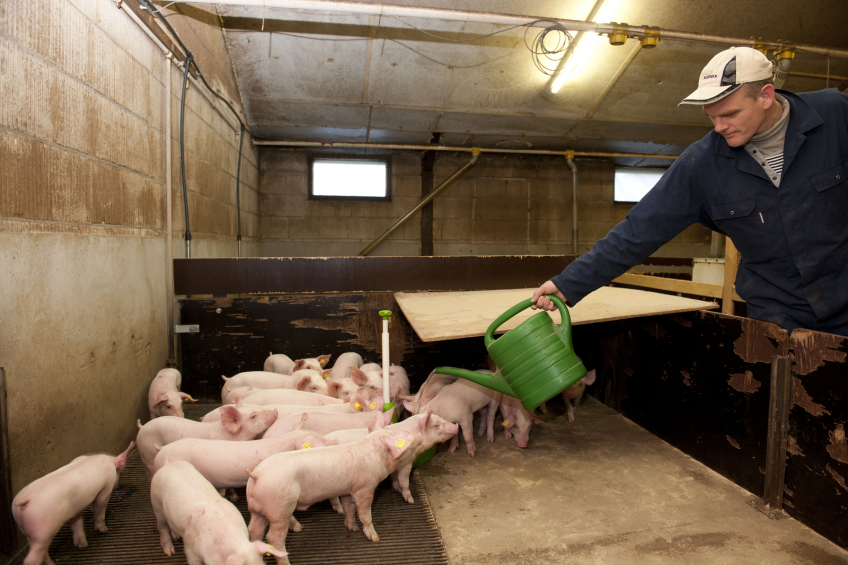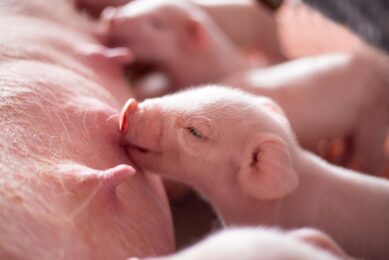Help pigs through weaning challenges

Weaning is one of the most stressful times in the pig production cycle. With changes in environment, management and nutrition, weaned pigs must adapt to new settings at a young age. To help pigs through this stressful period, supportive nutrition and care are essential, says Dan McManus, swine specialist for Purina Animal Nutrition.
The weaning transition can impact the long-term success of the group, siting a study where pigs with average daily gains (ADG) greater than 0.25 pounds in the first week post-weaning, reached market weight 15 days sooner than pigs that did not gain the first week post-weaning, according to McManus. “Any challenge in the early stages of the pig’s life can delay their long-term performance,” he says. “Our primary goals at weaning are to get the pigs drinking, eating and comfortable in their new social structure. These goals are the same for both healthy and health-challenged pigs.”
Dehydration the greatest concern
Dehydration is the greatest concern when pigs are removed from the sow, says Purina. According to the company, research shows only 51 percent of newly weaned pigs consume water in the first 25 hours post-weaning. “Young, lean pigs are made of up to 70 percent water, so any loss of hydration can be problematic,” McManus says. “Pigs who aren’t drinking are likely not eating. Because of this combination, death losses can occur when pigs lose just 15 percent of their bodyweight.”
Ways to prevent or overcome dehydration
According to Purina, promoting hydration pre-weaning and through the transition is essential. Two ways to help prevent or overcome dehydration are gel and electrolytes. Research from the Purina Animal Nutrition Center and the University of Manitoba showed that gel supports hydration, animal activity and feeding behavior while electrolytes provide essential nutrients through water. “During times of stress, we recommend providing free-choice gel and adding electrolytes to the water through a water medicator,” McManus says. “These two supportive tools have been shown to support increased water consumption and help pigs transition onto solid feeds.”
McManus recommends a mat feeding program for gel both pre- and post-weaning. “Place gel on the mats for at least 2 days pre-weaning; for the first 5 days post-weaning; and one day before and one day after vaccination,” he recommends. “In addition, provide gel free-choice during periods of stress, including disease and environmental pressures.”
Intestinal health
While gel can help transition pigs onto dry feed, electrolytes are formulated to promote intestinal health through increased water intake and added nutrients including sodium, chloride, potassium, calcium and magnesium. In a study evaluating the first 3 days post-weaning, early weaned pigs drank 4 times more water with electrolytes (3.748 L/pig/24h) compared to untreated tap water (836 mL/pig/24h). “Hydration is critical during this transition,” McManus says. “We need to provide young pigs all the nutrients we can to help them transition onto dry feed.”
Provide palatable feeds
According to McManus, once pigs are hydrated, they are more likely to transition onto solid feeds, especially if a similar feed was introduced pre-weaning. “Pigs are more capable of finding dry feed in the new facility if they are familiar with the feed,” McManus says. “If they are transitioning to a new building, with new penmates and new feed, there are too many variables for a smooth transition.” Delays in feed consumption at weaning are evident in research trials, according to Purina. In a trial on pigs weighing 11.7 pounds, feed intake was less than 0.1 pounds of dry feed per day in the first two days post-weaning. Feed intake increased to 0.6 pounds per day by day 8.
“Feed palatability plays a big role in this transition,” McManus says. “Feed very digestible feeds that include milk products – both before and after weaning. Palatability is important for all pigs, but especially those that are impacted by weaning, transport and health challenges.”
Creep feed prior to weaning
If possible, producers are encouraged to creep feed prior to weaning to introduce pigs to the flavors and textures of dry feed. The first feed post-weaning should be very similar to the creep feed to ease the transition. To help stimulate gut health and strengthen immunity, both feeds should include a complex combination of nutrients with a variety of amino acids, probiotics and neutraceuticals. “For pigs going through weaning or other challenges, the basics are very similar to normal pigs; only, if we make mistakes, they’re magnified,” McManus says. “We need to provide even more attention and supportive care to help them make the transition.”











